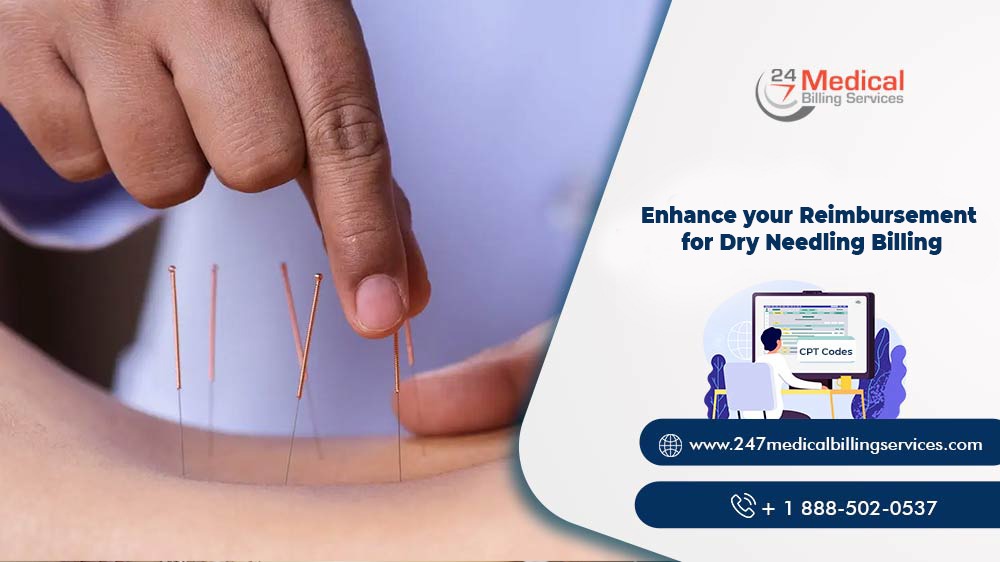
Enhance your Reimbursement for Dry Needling Billing
With more people opting for dry needling therapy, the complexity of the procedure is on the rise. This means the practices that offer dry needling need to understand how the codes and the billing work to ensure they get paid for their services.
Till 2020, there was no specific CPT code for dry needling. Thereafter, the therapists started using CPT Code 97140 to get reimbursement for the services offered. Not only this, the dry needling CPT codes have undergone a change due to the changing rules and regulations, and there are specific CPT codes for dry needling billing to be aware of. The core reason would be the rejection or denial of the payments if unlisted CPT codes were used for the services. Let’s have a detailed look at the CPT codes and dry-needling billing:
Know about the New Codes for Dry Needling Billing
The dry needling procedure is often referred to as Trigger Point Needling. The American Physical Therapy Association (APTA) and American Chiropractic Association (ACA) joined hands in 2009 to develop and get codes for dry needling services. The joint venture worked, and from January 1, 2020, the Centres for Medicare & Medicaid Services (CMS) assigned active Common Procedural Technology (CPT) Codes to dry needling procedures.
The new codes for dry-needling billing are as follows:
- 20560 Needle Insertion(s): In this, the needles are inserted in one to two muscles without any injection(s)
- 20561 Needle Insertion(s): In this, the needles are inserted without injections in three or more muscles.
How to Get Paid for Dry Needling Billing?
Despite CMS approving the two new CPT Codes for dry needling billing, they did not finalize them. Though CMS needs to put them under ‘always therapy’ or ‘sometimes therapy,’ instead, they are assigned a status that is referred to as non-covered. The only way that dry-needling billing CPT codes are to be paid is when the National Coverage Determination (NCD) is done. Other than this, the therapists are unlikely to get paid for the services by the insurance companies, Medicare and Medicaid.
Overall, the dry needling practice and the patients who need it are in a conundrum. However, there are a few ways that one can still get paid for dry needling while using the new CPT codes. These are as follows:
1. The Knowledge of the State About the Practice
Before you embark on providing dry needling service, you must check under the state practice act that it is legal to perform. It means:
- The scope of dry needling must be within the practice of physical therapy in the state
- As a practitioner, you must have the training and educational qualifications that will meet the requirement to perform dry needling service.
Though CPT codes exist for dry needling, the billing complication continues for the practices. One of the best ways to ensure revenue is not lost for trigger-needling procedures is by providing the service for on-the-spot cash payment.
2. Talk to the Payers
According to the director of state government affairs of APTA, APTA encourages the dry needling practitioner to understand the insurance policy and their attitude towards Trigger Point needling. The onus is on the practice to ask the insurance company whether they will pay for the procedures.
Also, the trigger needling practice must ask for the codes the insurance company likes to be used to pay for the procedures. The policies and regulations put in place by the insurance companies can vary for dry needling, so knowledge about it makes the coding and billing process more manageable and whether it is covered.
3. Seek Help from a Professional
Are you unable to handle the revenue collection for the dry-needling procedures? In that case, the best way to get paid for the services offered is to work with a professional dry-needling coding and billing company, such as 24/7 Medical Billing Services. They know how to work with the CPT codes of dry needling and get reimbursement for the services offered. Their process will ensure your practice does not lose money for the services rendered.
Until the CPT codes for dry needling are made workable by the CMS and other insurance companies, the procedure will continue to be a ‘hot potato’ even though people require the procedure for better health.
Read more: CPT Codes For Physical Therapy Billing

.png)